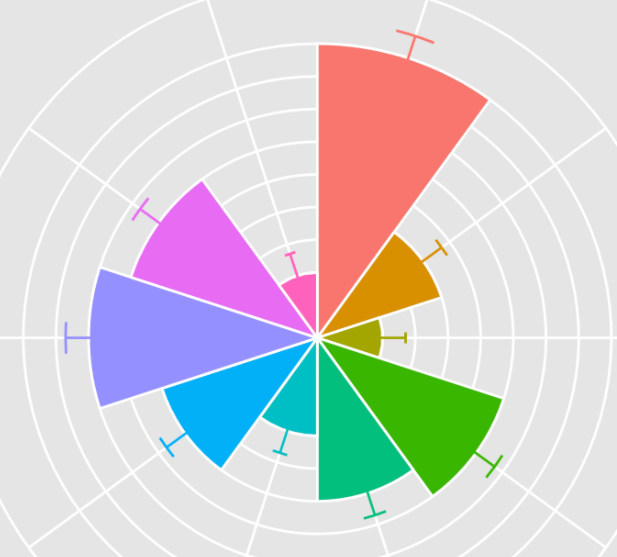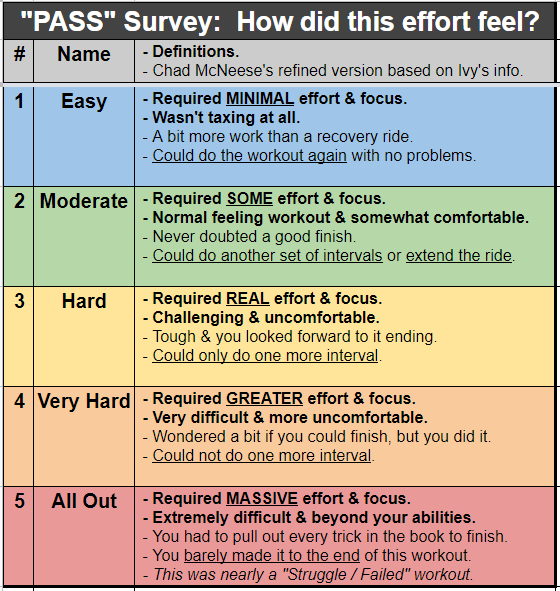Yeah, I don’t find the bar-chart visual for PLs very useful. Seeing the numbers in a table would be fine for me. If current values must be visualized graphically, I think one of these radial plots would work a lot better:

Ivy,
Not to beat a dead horse, but besides workout compliance / workout failure rate, it would be good to understand what else AT is designed to optimize for. If it is simply workout compliance, then the degenerative case would be to make every workout something like Lazy Mountain -1. No one would ever fail a workout, but neither would anyone get faster. So 100% workout compliance / completion is not the only objective. And I would argue that “failing” a certain % of workouts is actually healthy / leads to improved fitness, as if you never challenge yourself, how will you (or AT) know what you are really capable of doing? And this by definition means that sometimes the challenge is too great a challenge, but you won’t know that till you try.
Boy, talk about sympatico. On my 90 min endurance ride yesterday I was pondering my experience with AT beta, and found myself asking a similar question: If the purpose of TR is to “Make you a faster cyclist” then what is the TR team looking at to know that those who are following AT are getting faster “more better”![]() than those who are not? (That would also be using AT as designed without trying to game the system [not a judgement, as I am so tempted to try to ramp up PLs post-FTP change, and sometimes think “oh, and can do something harder than what’s on my plan for the day”])
than those who are not? (That would also be using AT as designed without trying to game the system [not a judgement, as I am so tempted to try to ramp up PLs post-FTP change, and sometimes think “oh, and can do something harder than what’s on my plan for the day”])
@IvyAudrain Without disclosing proprietary/competitive info, what insights might TR be able to provide – perhaps at least to those in the beta pool…
Pretty sure they hit on this in the release podcast (maybe others). It is far from just compliance. They looked at multiple factors and used the ML to try and find the “right mix” of progression in workouts that got appropriate gains matched with desired compliance.
I highly doubt it’s as simple as we might think if we were looking at graphs and charts of the many thousands of workouts, training plans and such. Because of that, I also expect we won’t get much in detail there since that is likely a huge piece of their project and not something appropriate to share (where competitors might leverage the info).
Definitely hearing you all that you’d like some more transparency about how Adaptive Training ‘measures its success’, I have to present that to the team and see how they’d like to speak to it. Thanks for your patience!
Plus I’d love AT to be able (some point in the future) give me actionable feedback. For example, I’ve done Festive 500 for the last several years, and this is a pretty large training block - 7 straight days, and ~1,400 TSS. Is this “good” for me? Or does this big a block ultimately harm my performance because it takes so much out of me that I suffer a big post Festive 500 training implosion?
I still might do Festive 500 because its a fun challenge, but I might try and reduce it / employ other strategies to try and minimize any negative impacts.
I have this issue with the F500 too - I want to keep doing it but I’m not sure it’s ultimately good for my training.
That is heaping a lot of hope onto AT…
It is ![]()
For me every big training overload week, at some point, delivers a fitness bump. Its all about managing the week or two after the overload ![]()
AT will never replace a coach, yourself and simple common sense ![]() at most it will prescribe easy spins as a workouts, nothing more.
at most it will prescribe easy spins as a workouts, nothing more.
Reading all the related topics I think people have some really high expectations about AT, but it is only a tool that can help a little bit with progressions through the workouts that users do not have to think if 3x15@FTP is harder than 2x20@FTP. I cannot imagine it can do anything more even if you feed it all the metrics in the world. Because there is a ton of aspects that cannot be quantified by any mathematical modeling (example - I have had very intensive and stressful weeks at work. I failed workouts that I could do 2 weeks earlier. My every parameter was in norm, even during the ride - but my mind was not. Today I have done the same workout with ease - just simply because today was an easier day at work).
Sorry for the digression and my 2 cents.
Not a digression. Perfect examples of why optimizing only for workout compliance / zero workout failure wouldn’t be a good solution.
The biggest problem with having AT manage fatigue/adapt your rides to recovery etc is a)athlete honesty, and b)athlete ego/expectation.
From what I’ve read, most people have a ready excuse when a workout is a fail or struggle (I’m the same), and want to keep moving forwards with their training without being able to see the forest for the trees.
…
Personally I think AT is on the right track and I’ve found the load just right and exploring my limits with workouts already. I think the TR team have some interesting ideas planned.
When it comes to me and my strange preferences I would trade AT for any decent plan builder not controlled by some things but rather combination of user preference and level.
For example:
I want to focus on my Vo2 max for 3 weeks, I choose time frame, zone with main focus, number of hours/wk or some other progression (could be even based on my previous weeks and training load). It could be expanded into secondary focus etc. This way I would have block that can be moved as a whole and used in the future as a template, but changed dynamically basing on my actualparameters like levels, tss, load ftp. This would be the most awesome feature. I would like some automation but with ability to use this automation as support of manual decisions.
But I am strange this way, as I like to have control over my training, and like to change things to see how my body will react. Maybe my biggest problem is the lack of features for “tinkers”, that like the process of choosing the workouts (if someone was playing Football Manager ever in his life know what I am talking about ;))
Edit ----
I have reflected that described almost old plan system, but with some twists. Maybe I am too old for this s… as someone has said ![]()
I do think after reading the SS Progression thread, that there’s merit in having VO2 Build, SS Build, Threshold Build as options for Build phase.
AT has been perfect for me so far. I’m bumping up to some pretty daunting looking threshold workouts though so it’ll be interesting to see, if I have a struggle at some point, how AT will then manage the load/progression.
For what it’s worth, I’m not talking about base being too easy in my case (I’m in build), it’s the fact that the system seemed to always make things easier when I set workouts as hard / very hard.
My faulty RPE meter perhaps, but it’s rare that even an “easy” workout feels easy to me. I’m not one of these riders that gets a endorphin boost from training, so they all feel pretty miserable to me.
Yeah, that is part of what sparked the large discussion based on the Pass/Success survey responses.
I refined the info from Ivy to try to get something that pulled her info into a partial “check list” where you can compare the TR based info and maybe pick the “correct” response despite our different experience and scales. Not claiming this is perfect, but some of the clarified info (especially the interval related stuff, shown as underlined) has helped me pick answers since that discussion.
Support got back to me, I’ll digest it properly when I am awake, but the latest version of AT does seem to be taking account of all workouts behind the scenes but isn’t displaying the results consistently on the calendar. Which is good to know. From the ride I done tonight it looks like future rides are displaying correctly and it’s just historic rides that are a bit hit or miss on the calendar and if they are all hits behind the scenes I consider it a success ![]()
20 posts were merged into an existing topic: AT: Easy vs Moderate vs Hard vs … [Pass / Success Survey Responses]
I’ve been basically following Chad’s table, it’s quite a handy way of looking at it.
To the above posters who are concerned about AT only prescribing easy workouts, the reductive example where AT just provides Lazy Mountain -1 to ensure compliance is obviously not how AT works - it only prescribes adaptations within the boundaries of the goals for that day (threshold, VO2 etc). The plans have an initial progression rate, if you find it too easy it increases the progression rate, and vice versa if you find it too hard. N=1, that works exactly as I anticipated, and it is categorically not too easy!
Earlier in the last block I ranked some threshold ones easy and it significantly bumped the difficulty. My PLs did start off a bit low in some areas when I first got on in May (personally, that was sweetspot/threshold), but selecting a couple of harder alternatives at the start evened it out pretty quickly. After that I was actually finding it too hard in the last block, so AT backed the progression off a bit, whereas just into this block I have been finding them a bit too easy (I guess after the rest week etc) so AT has bumped the future ones up. It’s basically been performing as expected from my perspective w.r.t. indoor workouts.
Specifically in this block I found the early VO2 ones a bit too easy (i.e., Cape Range which is basically 4x5 at 106% but with a 30s recovery in the middle of each 5 min) and my HR was nowhere near what I’d normally associate with VO2. I ranked it as such and now the later workouts look a lot more VO2-y.
What I found in Build especially is that in the old builds there used to be a couple of workouts which were absolutely killer, and several times I effectively abandoned my plan during build. Whereas this time round, I am now into Specialty with some nice gains (I have been setting season, 2021 and all-time power PRs this week and last!).
New functionality for linking outdoor rides looks like it will be a good help especially for the Z2 ones that I like to do outside. In future, when AT can finally work with any power trace, I expect I will be more likely to go out with a set of goals in mind (i.e., hit these 3 climbs at threshold), and have AT deal with it rather than mess around trying to find roads to follow the workouts exactly - something which is quite hard from where I live.
